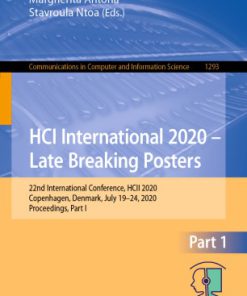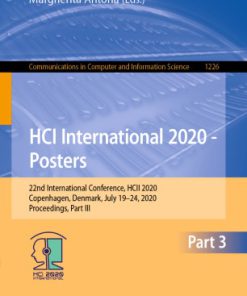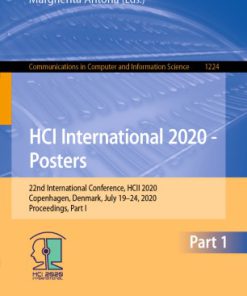HCI in Business, Government and Organizations 1st edition by Fiona Fui Hoon Nah, Keng Siau ISBN 3030503410 9783030503413
$50.00 Original price was: $50.00.$25.00Current price is: $25.00.
HCI in Business, Government and Organizations 1st edition by Fiona Fui-Hoon Nah, Keng Siau – Ebook PDF Instant Download/Delivery: 3030503410, 978-3030503413
Full download HCI in Business, Government and Organizations 1st Edition after payment

Product details:
ISBN 10: 3030503410
ISBN 13: 978-3030503413
Author: Fiona Fui-Hoon Nah, Keng Siau
This volume LNCS 12204 constitutes the refereed proceedings of the 7th International Conference on Business, Government, and Organizations, HCIBGO 2020, which was held in July 2020 as part of HCI International 2020 in Copenhagen, Denmark.*
1439 papers and 238 posters were accepted for publication after a careful reviewing process. The 42 papers presented in this volume are organized in topical sections named: digital transformation and intelligent data analysis and social media, digital commerce and marketing.
*The conference was held virtually due to the COVID-19 pandemic.
Chapter “The Effect of Queuing Technology on Customer Experience in Physical Retail Environments” is available open access under a Creative Commons Attribution 4.0 International License via link.springer.com.
HCI in Business, Government and Organizations 1st Table of contents:
1. Digital Transformation and Intelligent Data Analysis
This topic likely explores how organizations are adopting digital technologies to drive innovation, streamline operations, and make data-driven decisions. It also emphasizes the importance of data analysis, possibly through artificial intelligence (AI) or machine learning (ML), to unlock insights and create value.
2. Towards Conversational E-Government
Focuses on the use of conversational agents (chatbots, virtual assistants) in government services, improving citizen engagement, accessibility, and service delivery. This might examine how these technologies streamline public sector operations and enhance communication with citizens.
3. Designing Community-Based Open Innovation Platforms Based on Actual User Behavior
Examines how community-driven innovation can be fostered by leveraging platforms that adapt based on the behavior and feedback of users. This approach looks at open-source collaboration and innovation from a user-centric perspective.
4. Investigating Patients’ Visits to Emergency Departments: A Behavior-Based ICD-9-CM Codes Decision Tree Induction Approach
This paper likely discusses a machine learning approach to predict and understand patients’ visits to emergency departments based on their health behaviors and diagnoses, using ICD-9-CM codes to help develop decision trees for improving emergency healthcare services.
5. Massive Semantic Video Annotation in High-End Customer Service
Focuses on the use of semantic video annotation to analyze customer service interactions at scale, improving the quality of service through better understanding of customer needs, emotions, and feedback, possibly using AI to analyze video data.
6. Exploring Students’ Search Behavior and the Effect of Epistemological Beliefs on Contradictory Issues
Investigates how students’ beliefs about knowledge (epistemological beliefs) influence their search behavior when encountering conflicting information, potentially impacting their learning process and information processing strategies.
7. Exposing Undergraduate Students to the Challenges of Integrating Technology in Healthcare Delivery
This could explore educational efforts aimed at exposing students, particularly those in healthcare or technology fields, to the challenges of incorporating modern technologies (such as EHR systems, telemedicine, AI) in healthcare practices.
8. Detecting Deceptive Language in Crime Interrogation
Examines methods for detecting deceptive behavior or language in criminal interrogations, possibly through linguistic analysis, AI, or machine learning, aimed at identifying inconsistencies or lies in verbal and non-verbal cues.
9. Transformation Action Cycle
Likely refers to a framework or process for managing and implementing transformations in organizations, businesses, or governments. It may involve iterative cycles of change, assessment, and adaptation.
10. It’s About the Documents
This could address document management, digital transformation in document handling, or the role of documents in organizational processes (possibly focusing on knowledge management or digital document workflows).
11. Teamwork in Virtual World – Impact of “Virtual Team” on Team Dynamics
Explores how teams function and collaborate in virtual or digital environments, and how the dynamics of teamwork differ from physical, in-person teams. It might cover challenges such as communication, trust-building, and task delegation in virtual teams.
12. Insights from the Apple Human Interface Guidelines on Intuitive Interaction
Analyzes Apple’s Human Interface Guidelines, providing insights into creating intuitive and user-friendly digital interfaces. It could discuss design principles such as consistency, simplicity, and visual hierarchy to enhance user experiences.
13. The Effect of Queuing Technology on Customer Experience in Physical Retail Environments
Focuses on how modern queuing technology (e.g., virtual queues, mobile apps) impacts the customer experience in brick-and-mortar retail settings, possibly reducing wait times and improving satisfaction.
14. Protect Our Health with Cleaner Cars – How to Gain Customer Acceptance for Air Pollution Decreasing Retrofit Purchase
Looks at strategies for promoting the adoption of retrofitting vehicles with technologies that reduce air pollution, focusing on understanding customer behavior and overcoming resistance to purchasing these upgrades.
15. POS Product Presentation Concepts – Analysis of Affective, Conative and Cognitive Components in Decision Making
Investigates how product presentation in Point of Sale (POS) settings influences consumer decision-making, analyzing emotional (affective), conative (action-driven), and cognitive (thought-driven) factors that guide purchases.
16. A Review on Quality of Service and SERVQUAL Model
Discusses the SERVQUAL model, which is used to measure service quality, highlighting dimensions such as reliability, assurance, tangibles, empathy, and responsiveness, and how it applies to modern service industries.
17. Evaluating Potential of Gamification to Facilitate Sustainable Fashion Consumption
Explores the use of gamification techniques (e.g., rewards, challenges) to encourage sustainable fashion consumption, aiming to engage users and promote eco-friendly behaviors in fashion.
18. Features of Smart City Services in the Local Government Context: A Case Study of San Francisco 311 System
Examines the role of smart city services in local government, with a specific case study of San Francisco’s 311 system, which allows residents to report issues and access services through digital platforms.
19. Research on Cross-Cultural Participatory Design by Design Teams Based on Chinese Cultural Background
Focuses on how participatory design practices in cross-cultural settings (particularly in China) can improve the design process and outcomes, highlighting cultural considerations that impact collaboration and creativity.
20. Model-Based Systems Engineering for Sharing Economy Service Systems Design Using Structure-Behavior Coalescence Process Algebra
Looks at how systems engineering methods, particularly the Structure-Behavior Coalescence Process Algebra, can be used to design services within the sharing economy (e.g., Uber, Airbnb), modeling both the structure and behavior of service systems.
21. Forecasting the Subway Volume Using Local Linear Kernel Regression
Uses machine learning techniques, specifically local linear kernel regression, to predict subway ridership or traffic volume, potentially improving scheduling and service efficiency.
22. Predicting Music Emotion by Using Convolutional Neural Network
Explores the use of deep learning, specifically Convolutional Neural Networks (CNNs), to analyze and predict emotions conveyed in music, likely by analyzing audio features and patterns.
23. Social Media, Digital Commerce and Marketing
Explores the intersection of social media, digital commerce, and marketing strategies, emphasizing how businesses can leverage these platforms to engage customers, drive sales, and enhance brand presence.
24. The Challenges to Leverage User Generated Contents in B2B Marketing
Focuses on the challenges faced by B2B (business-to-business) marketers when leveraging user-generated content (UGC), including trust, authenticity, and scalability issues.
25. Investigating Linguistic Indicators of Generative Content in Enterprise Social Media
Looks at linguistic features (such as language use and tone) in enterprise social media and how these indicators can reveal patterns in generative content, such as user-generated posts or discussions.
26. Usability Studies of E-Commerce Checkout Process: A Perspective from Thailand
Explores the usability of e-commerce checkout processes, with a specific focus on Thailand, examining how design elements and user experiences influence conversion rates and customer satisfaction.
27. Effects of Avatar Cuteness on Users’ Perceptions of System Errors in Anthropomorphic Interfaces
Examines how the cuteness of avatars in anthropomorphic interfaces affects user perceptions, particularly regarding how users react to system errors or malfunctions.
28. Human-Computer Interaction Aspects of Enterprise Social Networks: An Empirical Validation of Adoption Model in a Developing Country
Studies the factors influencing the adoption of enterprise social networks in developing countries, focusing on HCI elements such as ease of use, perceived usefulness, and cultural factors.
29. Virtual Reality Online Shopping (VROS) Platform
Explores the potential of Virtual Reality (VR) to enhance online shopping experiences, allowing consumers to interact with products in 3D environments, improving engagement and decision-making.
30. Captivating Product Experiences: How Virtual Reality Creates Flow and Thereby Optimize Product Presentations
Examines how VR can create immersive experiences that engage consumers deeply, leading to the psychological state of “flow” and optimizing product presentations for better marketing outcomes.
31. How to Attract More Viewers in Live Streams? A Functional Evaluation of Streamers’ Strategies for Attraction of Viewers
Investigates strategies used by live streamers to attract and retain viewers, possibly looking at content types, interaction techniques, and the role of the streamer’s personality.
32. Identification of Key Factors Affecting Logistics Service Quality of Cross-border E-commerce
Examines the critical factors influencing the quality of logistics services in cross-border e-commerce, such as shipping times, customs regulations, and reliability.
33. Effects of Online Reviews on Consumer Evaluation of Products: How Are They Different Among Search, Experience and Credence Products?
Analyzes how online reviews affect consumer decision-making across different types of products: search (easily evaluated before purchase), experience (evaluated after use), and credence (difficult to assess even after purchase).
34. The Evolution of Marketing in the Context of Voice Commerce: A Managerial Perspective
Focuses on the rise of voice commerce (e.g., Amazon Alexa, Google Assistant) and how it is transforming marketing strategies, with implications for managers in adapting to voice-based shopping.
35. User Experience Testing vs. Marketing Experts – Can Empirical Research Beat Practical Knowledge in Dialog Marketing?
Explores the debate between empirical UX testing and marketing experts’ practical knowledge, evaluating how each contributes to the success of dialog-based marketing strategies.
36. Effectiveness of Banner Ads: An Eye Tracking and Facial Expression Analysis
Investigates the effectiveness of banner ads in digital marketing by using eye-tracking and facial expression analysis to understand user attention and emotional responses.
37. An Exploration of Personalization in Digital Communication. Insights in Fashion
Explores the role of personalization in digital communication within the fashion industry, examining how brands customize messaging to better connect with consumers.
38. Localization and Cultural Adaptation on the Web: An Explorative Study in the Fashion Domain
Investigates how global fashion brands adapt their websites and digital content to different cultural contexts to enhance user experience and market appeal.
39. FashionTouch in E-commerce: An Exploratory Study of Surface Haptic Interaction Experiences
Examines the use of surface haptic feedback in e-commerce to simulate touch interactions with products, enhancing the online shopping experience by engaging users through tactile sensations.
40. Cultural Appropriation in the Digital Context: A Comparative Study Between Two Fashion Cases
Explores the issue of cultural appropriation in digital fashion marketing, comparing two cases to understand how brands navigate the fine line between cultural appreciation and exploitation.
41. Digital User Behavior in Fashion E-Commerce. A Business Model Comparative Study
Compares business models in fashion e-commerce by analyzing digital user behavior, identifying what drives conversions and brand loyalty in different models.
42. The Effects of Cookie Notices on Perceived Privacy and Trust in E-Commerce
Investigates how cookie notices on e-commerce websites impact users’ perceptions of privacy and trust, potentially influencing their shopping behaviors and willingness to share data.
43. Research on Key Factors Affecting College Students’ Usage Intention of Green Public Welfare Activity Platform Based on DEMATEL Method
Applies the DEMATEL (Decision-Making Trial and Evaluation Laboratory) method to identify factors that affect college students’ intentions to use green public welfare activity platforms, potentially informing the design of eco-conscious apps.
44. Success Factors in Micro-Celebrity Endorsement: The Role of Informational and Narrative Content in Product Recommendation
Explores how micro-celebrities (individuals with niche followings) use informational and narrative content to influence product recommendations, examining the effectiveness of such endorsements in marketing.
45. Correction to: HCI in Business, Government and Organizations
An apparent correction or update related to human-computer interaction (HCI) in business, government, and organizational contexts, likely refining prior research or findings in this area.
People also search for HCI in Business, Government and Organizations 1st:
hci in business government and organizations
is hcl government company
quality control in a business
what is hci in information technology
6 government business systems
Tags:
Fiona Fui Hoon Nah,Keng Siau,HCI,Business,Government,Organizations 1st












